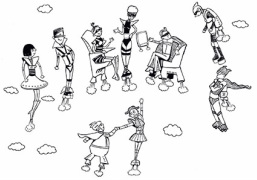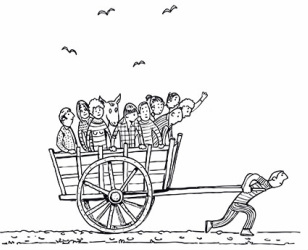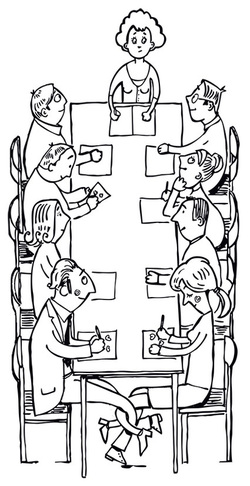
The future workshop is a pedagogic method, a way of working, to produce substantial ideas and visions. The number of participants should be limited to about 25 people. This method has a work form with a distinct framework that creates both freedom and safety, and also uses lust and creativity as driving forces.
The aim of this method is that all participants should find a common platform where they can develop and realise their ideas together. A successful future workshop is a good starting point for future actions and it often leads to the forming of working teams that continue to work on solutions and new development processes. There are various ways of performing a future workshop. The method requires moderators who are educated in the technique. Its main principles are participant governing, democracy and structure. Everyone’s ideas and views will be respectfully heard, discussed and entered into a common context. The method is based on having an overall theme, a subject or a condition that you want to change or develop. This theme is then treated in various ways in phases that runs from problem inventories to substantial decisions in action plans on what needs to be done, when it should be done, and sometimes even how it should be done and by whom. Various working materials are used, and there are supportive questions during the whole process. The future workshop is strictly disposed as regards time, and it is important that the stated time schedule is kept. The method may require a detailed follow-up to support the continued process in the working groups. The method is based on the participants’ active contributions and that they have the opportunity to be present during the whole process. It is an advantage to have a mixed group including politicians, officials, citizens and other interested parties. How you find the participants in the meeting may vary slightly. Either you could have an open meeting where participants can register or you invite selected participants. A combination could also be appropriate. Many perform the meeting during a public holiday so many can attend. A large hall with plenty of wall space is required. (SALAR)
A future workshop lasts for one to three days and includes five phases of equal importance: preparation phase, critique phase, fantasy phase, establishing phase, and implementation and follow-up phase.
Preparation phase
A theme is decided on and a workshop leader is chosen. In the preparation phase practical matters like the duration of the workshop, the place and invitations to the participants must also be arranged.
Critique phase
The critique phase opens the workshop proper, and the idea is that the whole group should together formulate the problems within the theme that was decided previously. The participants are then divided into smaller groups to analyse and try to understand the views that have come to light.
Fantasy phase
Now you should leave all negative thoughts behind and imagine what you want. Everyone can contribute visions and ideas of what they would like the future to look like. It does not have to be feasible or even realistic, just creative and sparkling.
Establishing phase
This is the most substantial phase of the workshop. Now all problems and visions are to be formulated as something workable. Groups are formed on the basis of various issues that have come to light and they discuss how to proceed, who should do what and when to do it.
Implementation and follow-up phase
Back home again everything should get going. The results from the workshop have been documented and must now be distributed to all concerned, participants in the workshop as well as those who did not take part. To keep the process going demands repeated follow-up meetings, and this requires leading lights to keep the steam up (Denvall & Salonen, 2000).
A future workshop requires quite some commitment from the participants for an extended period, since the method includes an implementation phase. It is probably more suited to an organisation or association with regular activity than a temporary user participation project. But the principle of various phases could be useful: first critique, and then solutions.
The aim of this method is that all participants should find a common platform where they can develop and realise their ideas together. A successful future workshop is a good starting point for future actions and it often leads to the forming of working teams that continue to work on solutions and new development processes. There are various ways of performing a future workshop. The method requires moderators who are educated in the technique. Its main principles are participant governing, democracy and structure. Everyone’s ideas and views will be respectfully heard, discussed and entered into a common context. The method is based on having an overall theme, a subject or a condition that you want to change or develop. This theme is then treated in various ways in phases that runs from problem inventories to substantial decisions in action plans on what needs to be done, when it should be done, and sometimes even how it should be done and by whom. Various working materials are used, and there are supportive questions during the whole process. The future workshop is strictly disposed as regards time, and it is important that the stated time schedule is kept. The method may require a detailed follow-up to support the continued process in the working groups. The method is based on the participants’ active contributions and that they have the opportunity to be present during the whole process. It is an advantage to have a mixed group including politicians, officials, citizens and other interested parties. How you find the participants in the meeting may vary slightly. Either you could have an open meeting where participants can register or you invite selected participants. A combination could also be appropriate. Many perform the meeting during a public holiday so many can attend. A large hall with plenty of wall space is required. (SALAR)
A future workshop lasts for one to three days and includes five phases of equal importance: preparation phase, critique phase, fantasy phase, establishing phase, and implementation and follow-up phase.
Preparation phase
A theme is decided on and a workshop leader is chosen. In the preparation phase practical matters like the duration of the workshop, the place and invitations to the participants must also be arranged.
Critique phase
The critique phase opens the workshop proper, and the idea is that the whole group should together formulate the problems within the theme that was decided previously. The participants are then divided into smaller groups to analyse and try to understand the views that have come to light.
Fantasy phase
Now you should leave all negative thoughts behind and imagine what you want. Everyone can contribute visions and ideas of what they would like the future to look like. It does not have to be feasible or even realistic, just creative and sparkling.
Establishing phase
This is the most substantial phase of the workshop. Now all problems and visions are to be formulated as something workable. Groups are formed on the basis of various issues that have come to light and they discuss how to proceed, who should do what and when to do it.
Implementation and follow-up phase
Back home again everything should get going. The results from the workshop have been documented and must now be distributed to all concerned, participants in the workshop as well as those who did not take part. To keep the process going demands repeated follow-up meetings, and this requires leading lights to keep the steam up (Denvall & Salonen, 2000).
A future workshop requires quite some commitment from the participants for an extended period, since the method includes an implementation phase. It is probably more suited to an organisation or association with regular activity than a temporary user participation project. But the principle of various phases could be useful: first critique, and then solutions.


 RSS Feed
RSS Feed
